Common menu bar links
Breadcrumb Trail
ARCHIVED - National Defence - Report
 This page has been archived.
This page has been archived.
Archived Content
Information identified as archived on the Web is for reference, research or recordkeeping purposes. It has not been altered or updated after the date of archiving. Web pages that are archived on the Web are not subject to the Government of Canada Web Standards. As per the Communications Policy of the Government of Canada, you can request alternate formats on the "Contact Us" page.
MINISTER'S MESSAGE
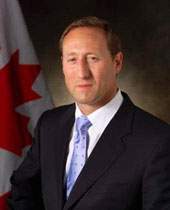
It is my pleasure to present to Parliament and Canadians the 2011-12 Report on Plans and Priorities for the Department of National Defence and the Canadian Forces (DND/CF) 1.
Canadians are rightly proud of the enormous contributions made by the DND and CF to protecting Canadians and supporting our interests and values, including by contributing to security and humanitarian operations. In 2011-12, the DND and CF will continue to ensure operational excellence by fulfilling the roles and missions outlined in the Canada First Defence Strategy (CFDS) - defending Canada and Canadians, remaining a strong and reliable partner in the defence of North America, and contributing to international peace and security.
The DND and CF are prepared to protect our citizens, respond to natural disasters and conduct search and rescue operations anywhere in Canada. The CF support the Government in exercising sovereignty in Canada's North by conducting routine and contingency missions in the region, such as Operation NANOOK. The DND and CF maintain our partnership with the United States in the defence of North America through activities such as collaboration within the North American Aerospace Defence Command (NORAD) and bilateral talks. We are strengthening the relationship with our most important ally through bilateral training and exercises, which ensure the continued interoperability of our armed forces and the defence of our shared continent.
Canadians recognize the sacrifices and achievements of the CF in Afghanistan. The DND and CF will maintain operational excellence abroad as we transition the Afghanistan mission to a non-combat training role. As demonstrated by their rapid and effective response to events in Newfoundland and Labrador and in Haiti, the CF remains prepared to deploy elsewhere at home and around the world as requested by the Government.
Continuing to deliver on our CFDS commitments while beginning the non-combat training mission in Afghanistan requires that resources are optimized to deliver on commitments, including by providing our military with the best training to ensure they can deploy rapidly. We are also increasing the flexibility of our investment plan to procure and maintain the equipment and infrastructure we need now and in the future. Through this balanced approach, the CF will remain an agile and flexible military, capable of meeting the needs of Canadians. While investments help modernize and rebuild the CF, they also continue to have a positive impact on Canadian communities by creating economic opportunities across the country.
I am honoured to lead this great national institution and I am proud of the professionalism and commitment demonstrated by the CF and the department's civilian personnel. I look forward to working with Parliament and Canadians on strengthening every aspect of the Defence Team.
Original to be signed by:
The Honourable Peter MacKay, P.C., M.P.
Minister of National Defence
SECTION I: DEPARTMENTAL OVERVIEW
Introduction
The Defence Team Mission is to provide combat-capable, multi-purpose forces for employment both at home and abroad to protect Canada and Canadians, and to deliver strategic effect for Canada. To accomplish this, Defence will be agile, flexible, affordable and resilient. We will raise, generate, employ and sustain world-class forces that work cohesively to advance Canadian interests and to maintain our reputation as a trusted and relevant partner at home and abroad.
Defence must be sustainable and serve the national interest. Our core responsibility is to succeed in operations while providing an affordable program of activities, preparing for future operational challenges and caring for our military members and their families.
The following recurring themes and challenges are highlighted within the report and outline the focus of our planned activities for the 2011-12 reporting period:
- Planning for, and implementing, the transition of the CF from a combat to non-combat role in Afghanistan in support of the Government of Canada's commitment to the North Atlantic Treaty Organization (NATO) Training Mission Afghanistan (NTM-A) where we will advance security, promote the rule of law and human rights, and support the delivery of humanitarian assistance to the Afghan people;
- Continuing to deliver on our Defence Priorities in support of the Government of Canada’s priorities; and
- Ensuring excellence in the management of Departmental resources.
The evolving global security environment continues to occupy the international agenda. Challenges include global terrorism, the enduring threat of regional conflicts emerging around the world, proliferation of weapons of mass destruction and conventional weapons, insurgencies and cyber attacks, piracy, and the global financial situation. The Defence Team continues to adapt and is prepared to meet these challenges.
Raison d'être and Responsibilities
The National Defence Act 2 establishes DND and the CF as separate entities, operating with an integrated National Defence Headquarters, as they pursue their primary responsibility of providing defence for Canada and Canadians.
On behalf of the people of Canada, Defence stands ready to perform three key roles:
- Defend Canada - by delivering excellence at home;
- Defend North America - by being a strong and reliable partner with the United States in the defence of the continent; and
- Contribute to International Peace and Security - by projecting leadership abroad.
The Defence mandate is carried out with the support of a group of related organizations and agencies within the portfolio of the Minister of National Defence. For further details on selected Defence Portfolio organizations, please refer to Section IV: Other Items of Interest - Selected Defence Portfolio HR and Financial Resources. For further information on the legislative framework within which Defence operates, please see Section IV: Other Items of Interest - Legislative Environment.
The Report on Plans and Priorities (RPP) for fiscal year 2011-12 is based upon the following foundational elements:
- The Defence Program Activity Architecture (PAA), which defines strategic outcomes and program activity areas and provides the planning, management and reporting structure for Defence;
- The Canada First Defence Strategy (CFDS), which mandates specific core missions and capability investments;
- The Defence Priorities for 2011-12, which identify specific commitment areas within Defence to which additional effort and resources are allocated to mitigate risks and thus enable the delivery of the Defence mandate; and
- The Corporate Risk Profile (CRP), which documents the key risks impacting Defence activities and their associated mitigation strategies.
Strategic Outcomes and Program Activity Architecture
Within Treasury Board Secretariat's Policy on Management, Resources and Results Structures 3 (MRRS) for planning, management and reporting, the Program Activity Architecture 4 sets out the strategic outcomes that are Defence's key method of tracking performance. While the PAA inventories activities undertaken by the Department, the strategic outcomes indicate the planned benefits arising from these activities.
Defence's four strategic outcomes, each supported by related program activities, are:
- Defence Operations will improve Peace, Stability and Security wherever deployed;
- National Defence is Ready to meet Government Defence Expectations;
- Resources are Acquired to meet Government Defence Expectations; and
- Care and Support to the Canadian Forces and Contribution to Canadian Society.
Each Defence Strategic Outcome and Program Activity is aligned to relevant Defence Priorities, Corporate Risks, and a Government of Canada Outcome Area. For further information, please refer to Section IV: Other Items of Interest - Departmental Link to Government of Canada Outcome Areas.
For a full illustration of the Defence PAA, please refer to Section IV: Other Items of Interest - Defence Program Activity Architecture. For descriptions of Defence strategic outcomes and associated program activities, please refer to Section II: Analysis of Program Activities by Strategic Outcome.
The Canada First Defence Strategy
To help Defence carry out our roles and responsibilities, the Canada First Defence Strategy5 (CFDS), released in May 2008, ensures a first-class, modern military that is well-trained, well-equipped and ready to take on the challenges of the 21st century.
To accomplish this, the CFDS provides a 20-year roadmap to modernize the CF with stable and predictable funding that permits long-term planning and investment in four Defence capability areas or pillars:
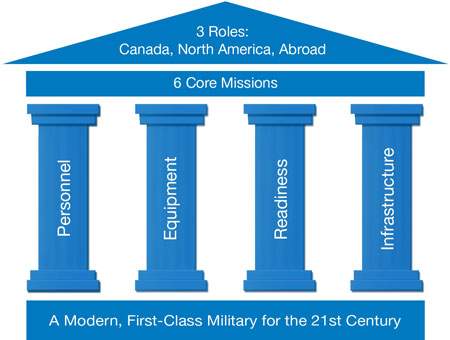
- Personnel: Expand the CF to a total strength of 100,000 (Regular 70,000/Reserve 30,000) by fiscal year 2027-28;
- Equipment: Renew the CF's core equipment platforms;
- Readiness: Maximize personnel training and equipment availability; and
- Infrastructure: to meet Canada's future defence and security requirements, the Government of Canada intends to replace or refurbish approximately 25 per cent of DND infrastructure holdings within 10 years, with approximately 50 per cent being replaced or refurbished over 20 years.
The CFDS articulates the broad strategic vision for Defence aligned with the level of ambition identified by the Government of Canada and outlines six core CF missions in domestic, continental and international contexts:
- Conduct daily domestic and continental operations, including in the Arctic and through the North American Aerospace Defense Command (NORAD);
- Support a major international event in Canada such as the G8, G20 and North American Leaders' Summits;
- Respond to a major terrorist attack;
- Support civilian authorities during a crisis in Canada such as a natural disaster;
- Lead and/or conduct a major international operation for an extended period; and
- Deploy forces in response to crises elsewhere in the world for shorter periods.
Risk Analysis
Defence is influenced by a wide range of factors, domestic and international, that have an impact on how we carry out our mandate. These factors present us with both risks and opportunities, which are taken into account as we deliver on our roles and responsibilities. Our continuous monitoring of emerging issues, developments and trends allows us to anticipate and respond to challenges, while mitigating risks.
The Corporate Risk Profile (CRP) documents the key risks facing Defence and has, therefore, an important influence on our planning and resource allocation decisions. It is a tool through which the executive leadership can provide guidance and direction to mitigate those Corporate Risks vital to the establishment and sustainment of the Defence mission. In general, operational and tactical risks are not elevated to the CRP as these are inherent to Defence's business and are managed on a day-to-day, routine basis.
The CRP is derived from the review of external and internal risks that require mitigation. For fiscal year 2011-12, three key Corporate Risks having a Defence-wide impact are highlighted. These are Defence Team Capacity Issues, Canadian Forces Reconstitution, and Investment Plan (IP) Flexibility. The key Corporate Risks, as well as their attendant mitigation actions, are presented below. To fulfill the Government of Canada's expectations, Defence will continue to manage these Corporate Risks in an effective manner.
| Risk | Action |
|---|---|
| Canadian Forces Reconstitution | Planning for the end of the combat mission in Afghanistan in 2011, and planning for CF readiness post-2011 including the Government of Canada's commitment to train the Afghan National Army after the end of the combat mission. |
| Defence Team Capacity | Placing priority on achieving the right balance and composition of the Defence workforce with focused attention on addressing military and civilian occupations of concern, and on leadership and professional development at all levels in the organization. |
| Investment Plan Flexibility | Ensuring that there is sufficient flexibility in the IP to address both emerging operational requirements and CF capability requirements of the future as outlined in the CFDS. |
In an effort to increase the visibility of the CRP in this report, Defence has developed a Defence Priorities - CRP - PAA Alignment Matrix6 , which illustrates the risks related to each Program Activity. See Section II: Analysis of Program Activities by Strategic Outcome for discussion of risks and associated mitigation strategies.
The Defence Priorities
The Defence Priorities are informed by the key Corporate Risks, and represent a focused number of areas where efforts and resources will be directed to mitigate those risk areas. Doing so addresses gaps in capability or capacity to enable Defence to act effectively on Government of Canada direction. To respond to the Government's priorities for Defence and support the activities essential to achieve excellence in our operations and management, the Defence Priorities articulated in RPP 2011-12 are:
- Ensuring Sustainable Operational Excellence both at Home and Abroad;
- Reconstituting and Aligning the CF Post-Afghanistan;
- Maintaining Defence Affordability; and
- Strengthening the Defence Team.
Defence Planning and Performance Reporting Framework
The following diagram illustrates the alignment of Defence's PAA, Risks and Priorities to the CFDS. This framework forms the basis for communicating Defence's planning story throughout this report.
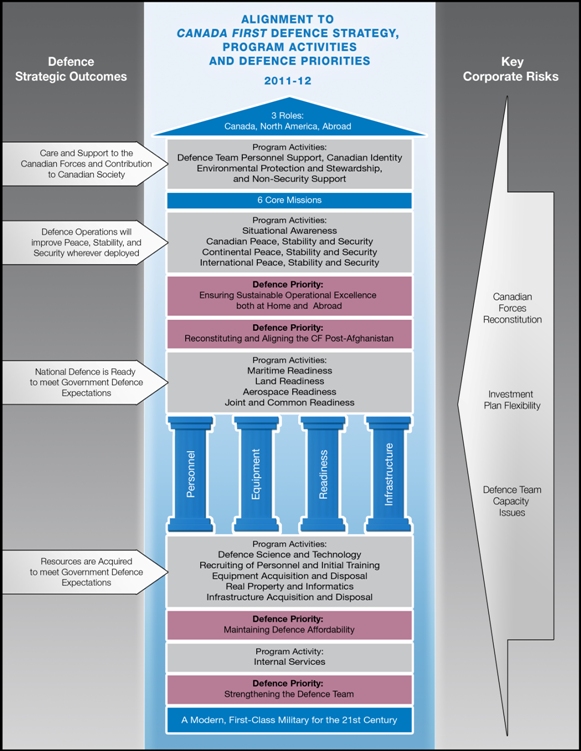
Contribution to the Federal Sustainable Development Strategy
Defence is a participant in the Federal Sustainable Development Strategy7 (FSDS). The Federal Sustainable Development Act8 establishes environmental sustainability as a long-term Government-wide priority, and requires the Government of Canada to develop and table an FSDS, integrating environmental sustainability and strategic environmental assessment as an integral part of its decision-making processes. Contributions are further explained in Sections II, III and IV.
Defence's contribution is through Theme IV: Shrinking the Environmental Footprint - Beginning with Government9. These contributions, and linkages to the PAA, are further explained in Section II: Analysis of Program Activities by Strategic Outcome.
![]()
The RPP uses this logo to indicate Defence activities that contribute to Theme IV of the FSDS. For additional details on Defence's activities to support sustainable development please see Section III: Supplementary Information - Greening Government Operations and both Section IV: Other Items of Interest - Sustainable Development and Section IV: Other Items of Interest - Strategic Environmental Assessment.
Planning Summary
| Financial Resources ($ thousands) | |||
|---|---|---|---|
| Planned Spending | |||
| 2011-12 | 2012-13 | 2013-14 | |
| Departmental Spending | 21,299,079 | 21,688,661 | 21,295,386 |
| Capital Spending (included in Departmental Spending) | 4,664,573 | 5,129,587 | 5,273,247 |
Human Resources
Over the next several years, we will adjust our personnel strategy to position Defence to meet future challenges and to deliver an affordable and sustainable Defence Program.
The long term objectives of the Regular and Reserve personnel, and civilian workforce are established as prescribed in the CFDS (70,000 Regular and 30,000 Reserve personnel by 2028; and 25,000 civilian workforce). The CFDS target to increase the effective strength of the Regular Force to 68,000 personnel was met ahead of the fiscal year 2011-12 schedule. As we plan for the end of the combat mission in Afghanistan and CF readiness post-2011, we will stabilize the Regular Force at 68,000 and ease the civilian workforce towards CFDS targets through natural attrition, over the next three fiscal years. We will also review the Reserve Force to determine a suitable Reserve employment model and validate the apportionment between Class A, Class B and Class C Reserves. Notwithstanding the above, we will need to determine the appropriate balance of personnel - Regular, Reserve and civilian - within the Department and across all Program Activities.
Human resource figures planned over the next three fiscal years are summarized in the following tables. For further explanation, please see endnotes. This data may be adjusted according to the outcome of the Strategic Review exercise.
| Human Resources Summary (Full-Time Equivalent - FTE) 10 | |||
|---|---|---|---|
| 2011-12 | 2012-13 | 2013-14 | |
| Regular Force | 68,000 | 68,000 | 68,000 |
| Primary Reserve (Class C) | 791 | 500 | 500 |
| Civilian - Departmental | 26,490 | 25,790 | 24,790 |
| Civilian - Organizations reporting directly to the Minister of National Defence* |
1,710 | 1,710 | 1,710 |
| TOTAL | 96,991 | 96,000 | 95,000 |
* Organizations reporting directly to the Minister of National Defence include Communications Security Establishment Canada, National Search and Rescue Secretariat, and the Office of the Ombudsman for the Department of National Defence and the Canadian Forces. For further details, please see Section IV: Other Items of Interest - Selected Defence Portfolio HR and Financial Resources.
| Human Resources Summary (Reserve Force Personnel) 11 | |||
|---|---|---|---|
| 2011-12 | 2012-13 | 2013-14 | |
| Primary Reserve (all classes) Total Strength | 34,750 | 34,750 | 34.750 |
| Primary Reserve (all classes) Average Paid Strength | 27,000 | 27,000 | 27,000 |
| Cadet Organizations Administration and Training Service | 8,000 | 8,000 | 8,000 |
| Canadian Rangers | 5,000 | 5,000 | 5,000 |
Data Sources: Director Human Resources Information Management (DHRIM) report, Assistant Deputy Minister (Finance and Corporate Services) Group Revised Pay System for the Reserves (RPSR) monthly records.
| Strategic Outcome | Defence Operations will Improve Peace, Stability and Security Wherever Deployed |
|---|---|
| Performance Indicators | Targets |
| % Effects Achieved (aggregate for all commands) | 80-100% |
| Program Activity | Forecast Spending 2010–11 |
Planned | Alignment to Government of Canada Outcome Area | |||
|---|---|---|---|---|---|---|
| 2011–12 | 2012–13 | 2013–14 | ||||
| Situational Awareness | CS | 150,960 | 105,310 | 95,526 | 97,137 | A safe and secure world through international cooperation |
| DS | 691,448 | 638,303 | 639,870 | 653,474 | ||
| Canadian Peace, Stability and Security | CS | 6,431 | 16,248 | 14,672 | 14,961 | A safe and secure Canada |
| DS | 394,647 | 282,628 | 287,759 | 296,368 | ||
| Continental Peace, Stability and Security | CS | 5,352 | 3,180 | 2,909 | 2,961 | A strong and mutually beneficial North American partnership |
| DS | 197,835 | 197,907 | 204,418 | 212,045 | ||
| International Peace, Stability and Security | CS | 541,121 | 319,451 | 290,174 | 295,873 | A safe and secure world through international cooperation |
| DS | 2,732,893 | 2,027,838 | 1,404,882 | 1,159,337 | ||
| Total Planned Spending | CS | 703,865 | 444,189 | 403,281 | 410,931 | |
| DS | 4,016,823 | 3,146,676 | 2,536,929 | 2,321,224 | ||
DS: Departmental Spending; CS: Capital Spending (included in Departmental Spending) | Due to rounding, figures may not add up to totals shown.
Note: The decrease in Departmental planned spending in fiscal year 2012-13 is largely a result of a decrease in planned spending under International Peace, Stability and Security.
| Strategic Outcome | National Defence is Ready to meet Government Defence Expectations |
|---|---|
| Performance Indicators | Targets |
| % Readiness level for Maritime, Land and Aerospace combined | 98-100% |
| Program Activity | Forecast Spending 2010–11 |
Planned | Alignment to Government of Canada Outcome Area | |||
|---|---|---|---|---|---|---|
| 2011–12 | 2012–13 | 2013–14 | ||||
| Maritime Readiness | CS | 2,709 | 32,554 | 29,760 | 30,302 | A safe and secure world through international cooperation |
| DS | 2,001,206 | 2,188,533 | 2,260,119 | 2,183,647 | ||
| Land Readiness | CS | 114,474 | 36,671 | 33,473 | 34,086 | A safe and secure world through international cooperation |
| DS | 4,167,518 | 3,630,264 | 3,829,067 | 3,725,108 | ||
| Aerospace Readiness | CS | 88,047 | 33,062 | 30,292 | 30,826 | A safe and secure world through international cooperation |
| DS | 2,400,509 | 1,883,626 | 1,952,555 | 1,872,254 | ||
| Joint and Common Readiness | CS | 197,953 | 176,309 | 198,477 | 205,895 | A safe and secure world through international cooperation |
| DS | 2,325,417 | 2,237,251 | 2,340,639 | 2,273,152 | ||
| Total Planned Spending | CS | 403,184 | 278,595 | 292,001 | 301,110 | |
| DS | 10,894,649 | 9,939,674 | 10,382,380 | 10,054,161 | ||
DS: Departmental Spending; CS: Capital Spending (included in Departmental Spending) | Due to rounding, figures may not add up to totals shown.
Note: The decrease in Departmental planned spending in fiscal year 2011-12 is largely a result of a decrease in planned spending under both Land Readiness and Aerospace Readiness.
| Strategic Outcome | Resources are Acquired to meet Government Defence Expectations |
|---|---|
| Performance Indicators | Targets |
| Performance against CFDS as measured by Investment Plan and Business Plans | 95-100% |
| Program Activity | Forecast Spending 2010–11 |
Planned | Alignment to Government of Canada Outcome Area | |||
|---|---|---|---|---|---|---|
| 2011–12 | 2012–13 | 2013–14 | ||||
| Defence Science and Technology | CS | 31,449 | 20,858 | 18,925 | 19,296 | An innovative and knowledge-based economy |
| DS | 373,338 | 327,069 | 334,420 | 343,461 | ||
| Recruiting of Personnel and Initial Training | CS | 9,338 | 2,610 | 2,367 | 2,414 | A safe and secure world through international cooperation |
| DS | 653,758 | 1,416,719 | 1,390,338 | 1,377,324 | ||
| Equipment Acquisition and Disposal | CS | 2,545,885 | 3,220,409 | 3,782,625 | 3,921,891 | A safe and secure world through international cooperation |
| DS | 2,691,307 | 3,498,227 | 4,089,999 | 4,193,603 | ||
| Real Property and Informatics Infrastructure Acquisition and Disposal | CS | 704,360 | 628,124 | 566,933 | 552,916 | Strong economic growth |
| DS | 775,843 | 665,501 | 606,161 | 593,215 | ||
| Total Planned Spending | CS | 3,291,032 | 3,872,000 | 4,370,850 | 4,496,516 | |
| DS | 4,494,246 | 5,907,517 | 6,420,918 | 6,507,603 | ||
DS: Departmental Spending; CS: Capital Spending (included in Departmental Spending) | Due to rounding, figures may not add up to totals shown.
Note: The increase in Departmental planned spending in fiscal year 2011-12 is largely a result of an increase in spending under Equipment Acquisition and Disposal and in Recruiting of Personnel and Initial Training.
| Strategic Outcome | Care and Support to the Canadian Forces and Contribution to Canadian Society |
|---|---|
| Performance Indicators | Targets |
| % Public support for the Canadian Forces | 85-100% |
| Program Activity | Forecast Spending 2010–11 |
Planned | Alignment to Government of Canada Outcome Area | |||
|---|---|---|---|---|---|---|
| 2011–12 | 2012–13 | 2013–14 | ||||
| Defence Team Personnel Support | CS | 15,580 | 21,254 | 19,313 | 19,684 | A safe and secure world through international cooperation |
| DS | 671,649 | 762,395 | 785,094 | 811,715 | ||
| Canadian Identity | CS | 11,099 | 15,053 | 13,666 | 13,932 | A vibrant Canadian culture and heritage |
| DS | 346,767 | 354,351 | 352,020 | 358,985 | ||
| Environment Protection and Stewardship | CS | 3,347 | 1,129 | 1,031 | 1,049 | A clean and healthy environment |
| DS | 152,090 | 134,365 | 138,044 | 142,216 | ||
| Non-Security Support | CS | 78 | 105 | 95 | 97 | A transparent, accountable and responsive federal government |
| DS | 21,503 | 7,165 | 6,717 | 6,666 | ||
| Total Planned Spending | CS | 30,104 | 37,541 | 34,105 | 34,763 | |
| DS | 1,192,009 | 1,258,275 | 1,281,875 | 1,319,582 | ||
DS: Departmental Spending; CS: Capital Spending (included in Departmental Spending) | Due to rounding, figures may not add up to totals shown
Note: The increase in Departmental planned spending in fiscal year 2011-12 is largely a result of an increase in planned spending under Defence Team Personnel Support.
| Internal Services | |||||
|---|---|---|---|---|---|
| Program Activity | Spending ($ thousands) | ||||
| Forecast 2010–11 |
Planned | ||||
| 2011–12 | 2012–13 | 2013–14 | |||
| Internal Services | CS | 63,865 | 32,248 | 29,350 | 29,928 |
| DS | 1,205,426 | 1,046,937 | 1,066,558 | 1,092,815 | |
DS: Departmental Spending; CS: Capital Spending (included in Departmental Spending) | Due to rounding, figures may not add up to totals shown.
Planned Spending for Fiscal Year 2011-12 by Program Activity
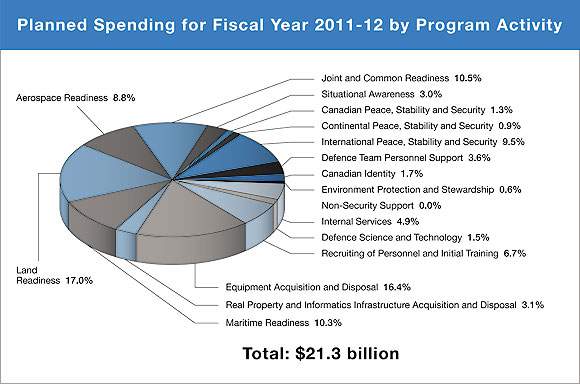
Financial Spending Trend
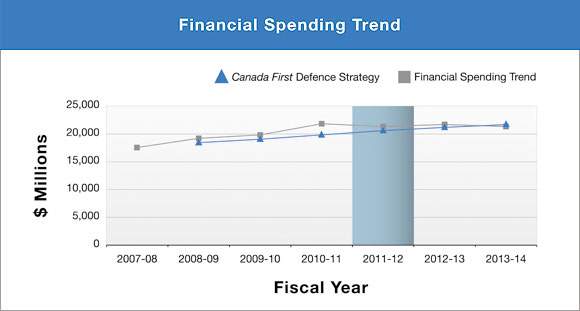
Notes: The change in financial spending trend between fiscal years 2010-11 up to 2013-14 is mainly attributable to capital equipment projects and incremental operations funding, such as the combat mission in Afghanistan. Details are provided in Section IV: Other items of interest - Departmental Planned Spending.
The Canada First Defence Strategy (CFDS) was approved beginning fiscal year 2008-09
Estimates by Vote
Estimates by Vote are presented in the Main Estimates for fiscal year 2011-12, available on the Treasury Board Secretariat (TBS) website.
The CF in Canada
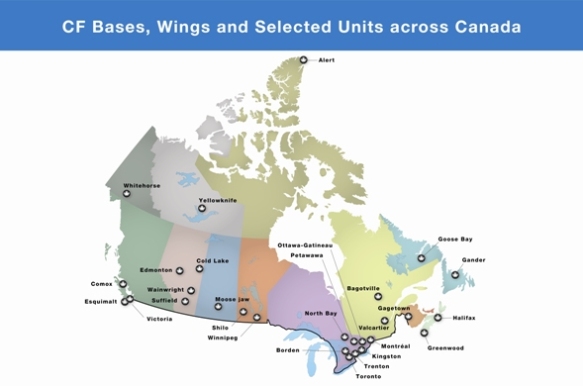
A complete listing of CF installations including bases, wings, stations and support units in Canada is available in Section IV: Other Items of Interest - Canadian Forces bases and wings co-located with civilian service centres across Canada.
